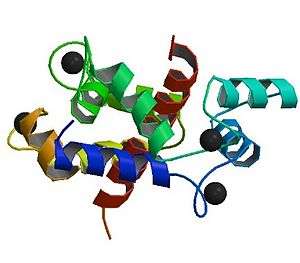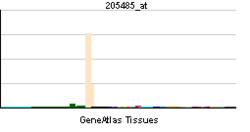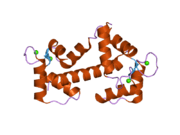RYR1
| View/Edit Human | View/Edit Mouse |
Ryanodine receptor 1 (RYR-1) also known as skeletal muscle calcium release channel or skeletal muscle-type ryanodine receptor is a protein found primarily in skeletal muscle. In humans, it is encoded by the RYR1 gene.[4][5]
Function
RYR1 functions as a calcium release channel in the sarcoplasmic reticulum, as well as a connection between the sarcoplasmic reticulum and the transverse tubule.[6] RYR1 is associated with the dihydropyridine receptor (L-type calcium channels) within the sarcolemma of the T-tubule, which opens in response to depolarization, and thus effectively means that the RYR1 channel opens in response to depolarization of the cell.
Clinical significance
Mutations in the RYR1 gene are associated with malignant hyperthermia susceptibility, central core disease, minicore myopathy with external ophthalmoplegia and samaritan myopathy, a benign congenital myopathy.[7] Alternatively spliced transcripts encoding different isoforms have been demonstrated.[6] Dantrolene may be the only known drug that is effective during cases of malignant hyperthermia.
Interactions
RYR1 has been shown to interact with:
See also
References
- ↑ "Drugs that physically interact with Ryanodine receptor 1 view/edit references on wikidata".
- ↑ "Human PubMed Reference:".
- ↑ "Mouse PubMed Reference:".
- ↑ Fujii J, Otsu K, Zorzato F, de Leon S, Khanna VK, Weiler JE, O'Brien PJ, MacLennan DH (Jul 1991). "Identification of a mutation in porcine ryanodine receptor associated with malignant hyperthermia". Science. 253 (5018): 448–51. doi:10.1126/science.1862346. PMID 1862346.
- ↑ Wu S, Ibarra MC, Malicdan MC, Murayama K, Ichihara Y, Kikuchi H, Nonaka I, Noguchi S, Hayashi YK, Nishino I (Jun 2006). "Central core disease is due to RYR1 mutations in more than 90% of patients". Brain. 129 (Pt 6): 1470–80. doi:10.1093/brain/awl077. PMID 16621918.
- 1 2 "Entrez Gene: RYR1 ryanodine receptor 1 (skeletal)".
- ↑ Böhm J, Leshinsky-Silver E, Vassilopoulos S, Le Gras S, Lerman-Sagie T, Ginzberg M, Jost B, Lev D, Laporte J (Oct 2012). "Samaritan myopathy, an ultimately benign congenital myopathy, is caused by a RYR1 mutation". Acta Neuropathologica. 124 (4): 575–81. doi:10.1007/s00401-012-1007-3. PMID 22752422.
- ↑ Fruen BR, Balog EM, Schafer J, Nitu FR, Thomas DD, Cornea RL (Jan 2005). "Direct detection of calmodulin tuning by ryanodine receptor channel targets using a Ca2+-sensitive acrylodan-labeled calmodulin". Biochemistry. 44 (1): 278–84. doi:10.1021/bi048246u. PMID 15628869.
- ↑ Cornea RL, Nitu F, Gruber S, Kohler K, Satzer M, Thomas DD, Fruen BR (Apr 2009). "FRET-based mapping of calmodulin bound to the RyR1 Ca2+ release channel". Proceedings of the National Academy of Sciences of the United States of America. 106 (15): 6128–33. doi:10.1073/pnas.0813010106. PMC 2662960
 . PMID 19332786.
. PMID 19332786. - ↑ Avila G, Lee EH, Perez CF, Allen PD, Dirksen RT (Jun 2003). "FKBP12 binding to RyR1 modulates excitation-contraction coupling in mouse skeletal myotubes". The Journal of Biological Chemistry. 278 (25): 22600–8. doi:10.1074/jbc.M205866200. PMID 12704193.
- ↑ Bultynck G, De Smet P, Rossi D, Callewaert G, Missiaen L, Sorrentino V, De Smedt H, Parys JB (Mar 2001). "Characterization and mapping of the 12 kDa FK506-binding protein (FKBP12)-binding site on different isoforms of the ryanodine receptor and of the inositol 1,4,5-trisphosphate receptor". The Biochemical Journal. 354 (Pt 2): 413–22. doi:10.1042/bj3540413. PMC 1221670
 . PMID 11171121.
. PMID 11171121. - ↑ Gaburjakova M, Gaburjakova J, Reiken S, Huang F, Marx SO, Rosemblit N, Marks AR (May 2001). "FKBP12 binding modulates ryanodine receptor channel gating". The Journal of Biological Chemistry. 276 (20): 16931–5. doi:10.1074/jbc.M100856200. PMID 11279144.
- ↑ Hwang SY, Wei J, Westhoff JH, Duncan RS, Ozawa F, Volpe P, Inokuchi K, Koulen P (Aug 2003). "Differential functional interaction of two Vesl/Homer protein isoforms with ryanodine receptor type 1: a novel mechanism for control of intracellular calcium signaling". Cell Calcium. 34 (2): 177–84. doi:10.1016/S0143-4160(03)00082-4. PMID 12810060.
- 1 2 3 Feng W, Tu J, Yang T, Vernon PS, Allen PD, Worley PF, Pessah IN (Nov 2002). "Homer regulates gain of ryanodine receptor type 1 channel complex". The Journal of Biological Chemistry. 277 (47): 44722–30. doi:10.1074/jbc.M207675200. PMID 12223488.
- ↑ Lee JM, Rho SH, Shin DW, Cho C, Park WJ, Eom SH, Ma J, Kim DH (Feb 2004). "Negatively charged amino acids within the intraluminal loop of ryanodine receptor are involved in the interaction with triadin". The Journal of Biological Chemistry. 279 (8): 6994–7000. doi:10.1074/jbc.M312446200. PMID 14638677.
- ↑ Caswell AH, Motoike HK, Fan H, Brandt NR (Jan 1999). "Location of ryanodine receptor binding site on skeletal muscle triadin". Biochemistry. 38 (1): 90–7. doi:10.1021/bi981306+. PMID 9890886.
- ↑ Guo W, Campbell KP (Apr 1995). "Association of triadin with the ryanodine receptor and calsequestrin in the lumen of the sarcoplasmic reticulum". The Journal of Biological Chemistry. 270 (16): 9027–30. doi:10.1074/jbc.270.16.9027. PMID 7721813.
- ↑ Groh S, Marty I, Ottolia M, Prestipino G, Chapel A, Villaz M, Ronjat M (Apr 1999). "Functional interaction of the cytoplasmic domain of triadin with the skeletal ryanodine receptor". The Journal of Biological Chemistry. 274 (18): 12278–83. doi:10.1074/jbc.274.18.12278. PMID 10212196.
Further reading
- Treves S, Anderson AA, Ducreux S, Divet A, Bleunven C, Grasso C, Paesante S, Zorzato F (Oct 2005). "Ryanodine receptor 1 mutations, dysregulation of calcium homeostasis and neuromuscular disorders". Neuromuscular Disorders. 15 (9-10): 577–87. doi:10.1016/j.nmd.2005.06.008. PMID 16084090.
External links
- RYR1 protein, human at the US National Library of Medicine Medical Subject Headings (MeSH)
- GeneReviews/NIH/UW entry on Multiminicore Disease
- GeneReviews/NCBI/NIH/UW entry on Malignant Hyperthermia Susceptibility
- RYR1 Variation Database
This article incorporates text from the United States National Library of Medicine, which is in the public domain.


